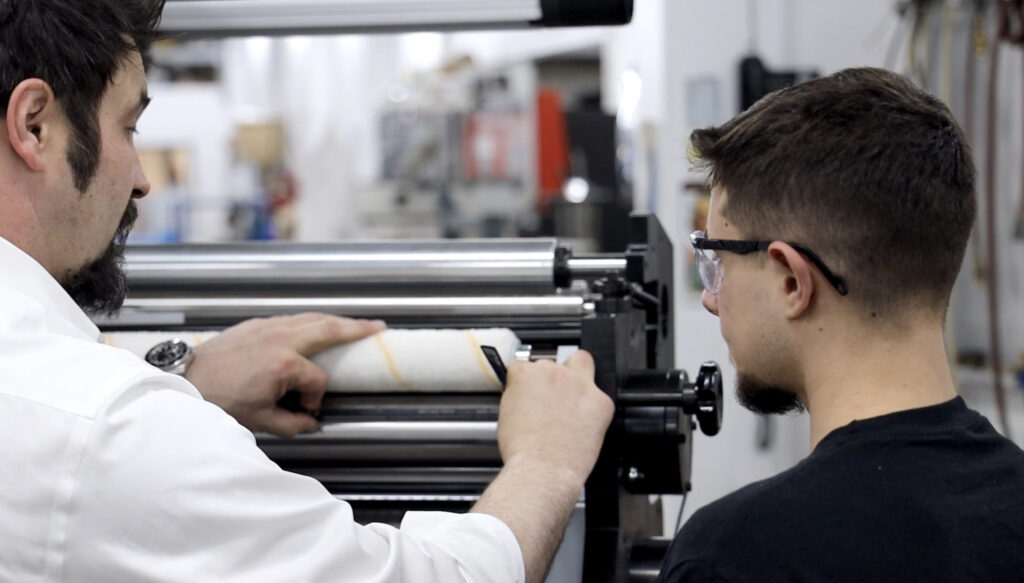Radiofrequency identification, RFID, is a method of uniquely identifying and tracking items such as assets or inventory by using radiofrequency waves. Information is encoded onto a microchip with a thin RFID tag or label, and an RFID reader activates and reads the information on the tag and passes it through a computer to parse the information and make it readily available. RFID tags operate with radiofrequency waves; therefore, they can work without line-of-sight scanning, which is required to scan UPC barcodes.
An RFID insertion machine, also called RFID inlay equipment or converting machinery and equipment, is used to insert RFID circuitry into labels or tags with an automated web-finishing process.
How RFID Converting Machinery Works
Tamarack® Products offers sophisticated RFID inlay insertion equipment to produce RFID tags, labels, and tickets on a new or existing Flexo press. Tamarack’s MVW Inline RFID is servo driven and integrates into your press typically after the print station and prior to the finishing station. The MVW Inline RFID provides quick setup and operator-friendly controls to insert dry or wet inlays on a simple web path.
Once the label face stock is printed, it is then delaminated from the release liner and routed to the MVW Inline RFID insertion module equipment. The roll of RFID inlays is unwound and fed to length, then routed to the vacuum applicator. A registration sensor on the inlay web ensures that the cutoff occurs between antenna repeats. The vacuum cylinder holds the inlay web in place until every inlay is cut and joined to the exposed adhesive of the stock web. The liner receives the hot melt adhesive in a patterned coating that eliminates any void of adhesive in the inlay area. The face stock label and the liner webs are then relaminated and then routed to the finishing section of the press.
Tamarck’s MVW Inline RFID Inlay Insertion Accommodates All Inlay Sizes
The MVW Inline RFID accommodates many different sizes of RFID inlays from 3/8” to 13” wide and 3/8” to 9” long, which meets the requirements for all inlay products. Achieve a simple and straightforward setup with touchscreen controls to enter job parameters. Enjoy productivity and flexibility with servo-driven components. Tamarack’s MVW Inline can be adapted to be installed in different locations of the press. Servo-driven technology allows affixing inlays on all repeating label sizes without changing gears or cylinders.
Our customers appreciate our flexible and modular solutions, which support growth without the need to purchase new equipment. The MVW Inline provides one wide operation to start with, and components can be added later to accommodate an increase in production demands. A second station can be added for a two-stream operation and can accommodate inlay verification systems.
Tamarack’s MVW Inline meets current production concerns with smart label capability, such as removing defective tags, and provides high-volume production.
Specifications include:
- Operation – Servo driven, rotary vacuum cylinder approach, affixes roll-fed materials
- Web widths – designed to accommodate press widths from 10” to 20”, with other widths available
- Inlay dimensions – from 3/8” to 13” wide, and 3/8” to 9” long
- Inlay roll sizes – roll diameter up to 20” wide, roll core diameter to 3”
- Hot melt system – hot melt adhesive is applied to the liner and is extruded for continuous or pattern coating
- Electrical requirements – 380 to 480 V, 3 phase, 50/60 Hz, 30 amp
Also available are static elimination systems, defective inlay removal, and reader integration.
Easily produce RFID smart labels, tags, and tickets with Tamarack’s MVW Inline RFID inlay insertion system.
Tamarack® Products is recognized as an industry-leading manufacturer of specialized, high-quality, in-line, and off-line web finishing machinery. We offer RFID inlay insertion and integrated labeling solutions, as well as window patching and other web finishing production solutions. Contact us to learn more about integrating RFID inlay insertion systems with modular and flexible web finishing solutions.





